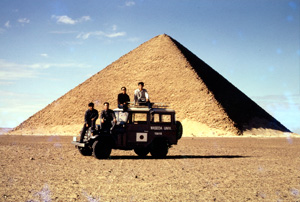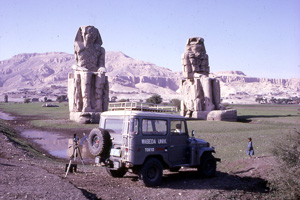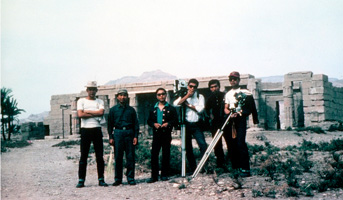History of the Waseda University Egyptian Expedition

 The Waseda University Egyptian expedition started its first general survey in 1966.Since then, we have conducted field work in Egypt for 40 years. I and the late Prof.Kiichi Kawamura, who was the general director of the mission at that time, were searching for a suitable site to be excavated along the Nile Valley in several times between 1966 and 1970. The Waseda University Egyptian expedition started its first general survey in 1966.Since then, we have conducted field work in Egypt for 40 years. I and the late Prof.Kiichi Kawamura, who was the general director of the mission at that time, were searching for a suitable site to be excavated along the Nile Valley in several times between 1966 and 1970.
The first site we chose among them was Deir el-Bersha near el-Minia in the middle Egypt. In 1970 this site was suddenly designated an area where foreigners was prohibited from entering in. So we had to select another site again. However, it was lucky for us. We were granted the permission to work at Malkata where it was easy to access because it was near Luxor and its local people are familiar with foreigners. It meant that a desirable condition for excavating the site was satisfied.
We have made a number of important results for 40 years. At first, it was often said to be beginners luck. I would have thought so too. After 10 years, I had an idea that I should not have thought so. Therefore, I introduced a method that applies modern technology to archaeology. This resolves that earth’s physical elements with geophysical sensing instruments and has dozens of ways. We used five methods among them and actually tried and tested them in Egypt. Particularly, electromagnetic wave method was more useful and its result was helpful for us to achieve fame. The site of Abusir where we have been excavating was found by underground radar system using electromagnetic wave method.
Geophysical survey in the Valley of the King is being suspended before the underground radar system did not fully prove its capability in the survey due to the ongoing conservation project at the tomb of Amenhotep III. This project was an international project by a trust fund of Japan’s foreign ministry through UNESCO. We have completed the second phase of the project and received a high evaluation from the Supreme Council of Antiquities of Egypt. We plan to resume the investigation in the Valley of the Kings after this project is finished.
The discovery of the site of Dahshur North made a great impact on the field of Egyptology because this site was the first subterranean archaeological remain found by analysis of satellite images, while some above ground sites in Yucatan Peninsula were found by the same method. This project was collaborative research with Tokai University. Another important discovery was the boat pit of the second boat of Khufu on the south of the Great Pyramid at Giza. This was found by electromagnetic ground radar. Now we are preparing for excavating, restoring and reconstructing it.
As stated above, we have five projects which have international reputation. We are deeply grateful to be involved in such projects.
Prof. Dr. Sakuji Yoshimura
Director of Waseda University Egyptian Expedition
 
|